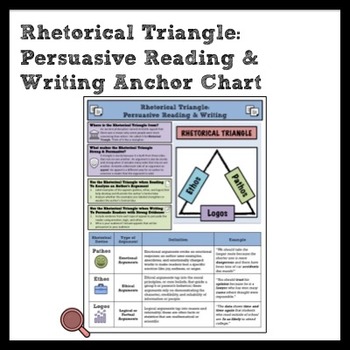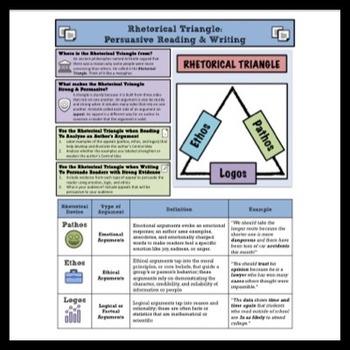Rhetorical Triangle: Persuasive Reading & Writing Quick Reference Anchor Chart
Middle School Writer
358 Followers
Grade Levels
7th - 12th
Subjects
Resource Type
Standards
CCSSRI.7.1
CCSSRI.7.2
CCSSRI.7.3
Formats Included
- Zip
Pages
2 pages
Middle School Writer
358 Followers
Description
HOW DOES THIS RELATE TO COMMON CORE/ TNREADY?
Common Core aligned standards require students to do more than read and write. They must be able to analyze the effectiveness of an argument (hint Rhetorical Triangle) and construct persuasive arguments. Students need scaffolds to get there. Teach students to analyze author’s craft and apply lessons learned in their own writing using the rhetorical triangle. Make an abstract concept concrete with this quick reference. This is a must have on the wall in your classroom and in your students’ binders to pull out every time they read persuasive texts and write persuasively.
WHAT IS IT?
★ An anchor chart to be printed and hung in your room
-AND-
★ A one-page quick reference to print for students to use all year when reading persuasive texts and writing persuasively
WHAT'S THE CONTENT?
★ Where the Rhetorical Triangle came from, why it’s strong/persuasive in writing, how to use the rhetorical triangle when analyzing a text and writing persuasively
★ Diagram of the Rhetorical Triangle
★ Quick Reference table with the appeal, definition, and examples
HOW DO I USE IT?
Print and give to all students. Require students to have next to a text they’re analyzing or an essay they are drafting.
Hang it in your room as a constant reference for students.
Remind students where the Rhetorical Triangle came from and why it strengthens writing. Students can’t just know the appeals, they must know how the appeals work together and why each appeal is persuasive.
WHAT'S INCLUDED?
★ PPT Quick Reference
★ PDF formatted as an 8.5 by 11 (Ready to Print)
CHECK OUT THESE RELATED RESOURCES:
Author's Craft & Rhetorical Devices Anchor Chart + Foundational Student Handout
Comma Rules Anchor Chart
TNReady Item Sampler Alignment and ALL TEACHING GUIDES for Middle School ELATNReady Main Idea & Central Idea Lesson and Guided PracticeTNReady Need to Know: Resources & Test Overview
(Written by Middle School Writer, Mara Truslow, Copyright 2016).
Common Core aligned standards require students to do more than read and write. They must be able to analyze the effectiveness of an argument (hint Rhetorical Triangle) and construct persuasive arguments. Students need scaffolds to get there. Teach students to analyze author’s craft and apply lessons learned in their own writing using the rhetorical triangle. Make an abstract concept concrete with this quick reference. This is a must have on the wall in your classroom and in your students’ binders to pull out every time they read persuasive texts and write persuasively.
WHAT IS IT?
★ An anchor chart to be printed and hung in your room
-AND-
★ A one-page quick reference to print for students to use all year when reading persuasive texts and writing persuasively
WHAT'S THE CONTENT?
★ Where the Rhetorical Triangle came from, why it’s strong/persuasive in writing, how to use the rhetorical triangle when analyzing a text and writing persuasively
★ Diagram of the Rhetorical Triangle
★ Quick Reference table with the appeal, definition, and examples
HOW DO I USE IT?
Print and give to all students. Require students to have next to a text they’re analyzing or an essay they are drafting.
Hang it in your room as a constant reference for students.
Remind students where the Rhetorical Triangle came from and why it strengthens writing. Students can’t just know the appeals, they must know how the appeals work together and why each appeal is persuasive.
WHAT'S INCLUDED?
★ PPT Quick Reference
★ PDF formatted as an 8.5 by 11 (Ready to Print)
CHECK OUT THESE RELATED RESOURCES:
Author's Craft & Rhetorical Devices Anchor Chart + Foundational Student Handout
Comma Rules Anchor Chart
TNReady Item Sampler Alignment and ALL TEACHING GUIDES for Middle School ELATNReady Main Idea & Central Idea Lesson and Guided PracticeTNReady Need to Know: Resources & Test Overview
(Written by Middle School Writer, Mara Truslow, Copyright 2016).
Total Pages
2 pages
Answer Key
N/A
Teaching Duration
Lifelong tool
Report this resource to TPT
Reported resources will be reviewed by our team. Report this resource to let us know if this resource violates TPT’s content guidelines.
Standards
to see state-specific standards (only available in the US).
CCSSRI.7.1
Cite several pieces of textual evidence to support analysis of what the text says explicitly as well as inferences drawn from the text.
CCSSRI.7.2
Determine two or more central ideas in a text and analyze their development over the course of the text; provide an objective summary of the text.
CCSSRI.7.3
Analyze the interactions between individuals, events, and ideas in a text (e.g., how ideas influence individuals or events, or how individuals influence ideas or events).



